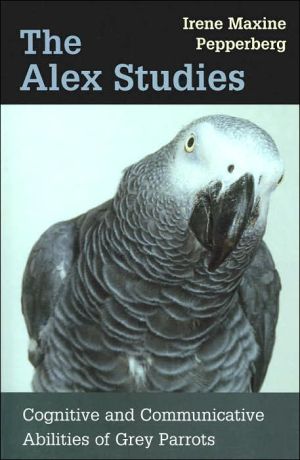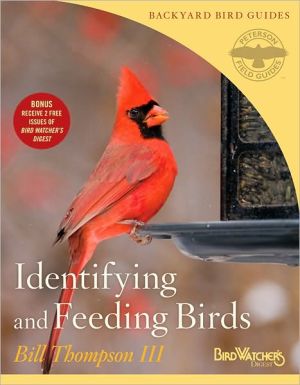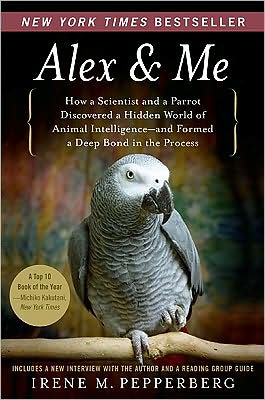The Alex Studies: Cognitive and Communicative Abilities of Grey Parrots
Can a parrot understand complex concepts and mean what it says? Since the early 1900s, most studies on animal-human communication have focused on great apes and a few cetacean species. Birds were rarely used in similar studies on the grounds that they were merely talented mimics—that they were, after all, "birdbrains." Experiments performed primarily on pigeons in Skinner boxes demonstrated capacities inferior to those of mammals; these results were thought to reflect the capacities of all...
Search in google:
Can a parrot understand complex concepts and mean what it says? Since the early 1900s, most studies on animal-human communication have focused on great apes and a few cetacean species. Birds were rarely used in similar studies on the grounds that they were merely talented mimics—that they were, after all, "birdbrains." Experiments performed primarily on pigeons in Skinner boxes demonstrated capacities inferior to those of mammals; these results were thought to reflect the capacities of all birds, despite evidence suggesting that species such as jays, crows, and parrots might be capable of more impressive cognitive feats.Twenty years ago Irene Pepperberg set out to discover whether the results of the pigeon studies necessarily meant that other birds—particularly the large-brained, highly social parrots—were incapable of mastering complex cognitive concepts and the rudiments of referential speech. Her investigation and the bird at its center—a male Grey parrot named Alex—have since become almost as well known as their primate equivalents and no less a subject of fierce debate in the field of animal cognition. This book represents the long-awaited synthesis of the studies constituting one of the landmark experiments in modern comparative psychology. Edward Kako Pepperberg's work is admirably rigorous. Earlier work with language-trained animals was notorious for poor design and overly charitable interpretations of data. Pepperberg, by contrast, takes careful precautions against inadvertent cueing. She uses conservative estimates of chance when assessing the statistical reliability of Alex's responses, and she shows restraint when interpreting her results...Pepperberg has organized her book in a quasi-historical fashion, framing each phase of her research in terms of the contemporary work that inspired or informed it. Each chapter is devoted to a particular capacity or competence, such as numerical cognition, categorization, or the comprehension of words...From those who wish to read selectively (or for instructors who wish to assign only one or two chapters it should be quite welcome because each chapter can stand on its own reasonably well...The book should be accessible to a wide range of audiences, from researchers studying animal behavior to advanced undergraduates in a course that covers relevant material such as animal cognition or the capacities of language-trained animals.
Preface1. Introduction: In Search of King Solomon's Ring2. Can We Really Communicate with a Bird?3. Can a Parrot Learn Referential Use of English Speech?4. Does a Parrot Have Categorical Concepts?5. Can a Parrot Learn the Concept of Same/Different?6. Can a Parrot Respond to the Absence of Information?7. To What Extent Can a Parrot Understand and Use Numerical Concepts?8. How Can We Be Sure That Alex Understands the Labels in His Repertoire?9. Can a Parrot Understand Relative Concepts?10. What Is the Extent of a Parrot's Concept of Object Permanence?11. Can Any Part of a Parrot's Vocal Behavior Be Classified as "Intentional"?12. Can a Parrot's Sound Play Assist Its Learning?13. Can a Parrot's Sound Play Be Transformed into Meaningful Vocalizations?14. What Input Is Needed to Teach a Parrot a Human-based Communication Code?15. How Similar to Human Speech Is That Produced by a Parrot?16. How Does a Grey Parrot Produce Human Speech Sounds?17. Conclusion: What Are the Implications of Alex's Data?NotesReferencesGlossaryCreditsIndex
\ Animal BehaviourWhat distinguishes the work of Pepperberg from that of the majority of researchers working with language- trained apes is that she is truly interested in the underlying cognitive processes involved in her subject's behaviour. She thus asks questions and then designs experiments to test the possibilities this book represents a scholarly reporting of a scientist's quest to understand the mind of another species in as honest and rigorous a manner as is possible, under the circumstances of being both "parent" and investigator.\ — Michael Tomasello and Josep Call\ \ \ \ \ \ New York Times Book ReviewAlex's spectacular abilities were sensationalized in the news media, as though it were a talking parrot act. That obscured the significance of the studies, which is why The Alex Studies is important...[Irene Pepperberg has] done groundbreaking experiments, and bringing them together in a panoramic view is a great service...She describes simply what she did, and why and how her results compare with equivalent language-use and comprehension studies on chimps, marine mammals and children...She proves that animals have abilities greater than we are led to expect, but these can be revealed only by appropriate research tools. She succeeds where many others failed, and she convinces us that the details of investigative methods are what matter. The purpose is not to reveal Alex as a winged Einstein. Instead, she shows that complex mental operations are revealed only be precise methods that match the capabilities investigated. And she demonstrates remarkable parallels between parrots and humans. The core importance of social interaction in both learning and testing is crucial for her results. In that, her studies have relevance far beyond parrots.\ — Bernd Heinrich\ \ \ \ Los Angeles TimesAlex's abilities are extraordinary, and Pepperberg's investigation of them makes The Alex Studies essential for anyone interested in the wider issues it raises...As with other pioneering works from Darwin's to E. O. Wilson's, its influence will be felt throughout the field of animal ethology for years to come.\ — Caroline Fraser\ \ \ \ \ \ SciencePepperberg's work is admirably rigorous. Earlier work with language-trained animals was notorious for poor design and overly charitable interpretations of data. Pepperberg, by contrast, takes careful precautions against inadvertent cueing. She uses conservative estimates of chance when assessing the statistical reliability of Alex's responses, and she shows restraint when interpreting her results...Pepperberg has organized her book in a quasi-historical fashion, framing each phase of her research in terms of the contemporary work that inspired or informed it. Each chapter is devoted to a particular capacity or competence, such as numerical cognition, categorization, or the comprehension of words...From those who wish to read selectively (or for instructors who wish to assign only one or two chapters) it should be quite welcome because each chapter can stand on its own reasonably well...The book should be accessible to a wide range of audiences, from researchers studying animal behavior to advanced undergraduates in a course that covers relevant material such as animal cognition or the capacities of language-trained animals.\ — Edward Kako\ \ \ \ \ \ Bernd HeinrichAlex's spectacular abilities were sensationalized in the news media, as though it were a talking parrot act. That obscured the significance of the studies, which is why The Alex Studies is important...[Irene Pepperberg has] done groundbreaking experiments, and bringing them together in a panoramic view is a great service...She describes simply what she did, and why and how her results compare with equivalent language-use and comprehension studies on chimps, marine mammals and children...She proves that animals have abilities greater than we are led to expect, but these can be revealed only by appropriate research tools. She succeeds where many others failed, and she convinces us that the details of investigative methods are what matter. The purpose is not to reveal Alex as a winged Einstein. Instead, she shows that complex mental operations are revealed only be precise methods that match the capabilities investigated. And she demonstrates remarkable parallels between parrots and humans. The core importance of social interaction in both learning and testing is crucial for her results. In that, her studies have relevance far beyond parrots.\ \ \ \ \ Caroline FraserAlex's abilities are extraordinary, and Pepperberg's investigation of them makes The Alex Studies essential for anyone interested in the wider issues it raises...As with other pioneering works from Darwin's to E. O. Wilson's, its influence will be felt throughout the field of animal ethology for years to come.\ \ \ \ \ Edward KakoPepperberg's work is admirably rigorous. Earlier work with language-trained animals was notorious for poor design and overly charitable interpretations of data. Pepperberg, by contrast, takes careful precautions against inadvertent cueing. She uses conservative estimates of chance when assessing the statistical reliability of Alex's responses, and she shows restraint when interpreting her results...Pepperberg has organized her book in a quasi-historical fashion, framing each phase of her research in terms of the contemporary work that inspired or informed it. Each chapter is devoted to a particular capacity or competence, such as numerical cognition, categorization, or the comprehension of words...From those who wish to read selectively (or for instructors who wish to assign only one or two chapters it should be quite welcome because each chapter can stand on its own reasonably well...The book should be accessible to a wide range of audiences, from researchers studying animal behavior to advanced undergraduates in a course that covers relevant material such as animal cognition or the capacities of language-trained animals.\ \ \ \ \ BooknewsLots of people talk about how smart their pets are, but few have the credentials of Pepperberg (ecology evolutionary biology and psychology, U. of Arizona; media arts and sciences, Massachusetts Institute of Technology). For 20 years she has been questioning Skinner's dismissal of avian intelligence<-->based on pigeons<-- >by looking at large-brained, highly social parrots, and in particular a male Grey named Alex. She reports that he has a vocabulary of about 100 words, and has learned such tasks as object identification, categorization, concepts of same/different, absence, relative size, and number. Annotation c. Book News, Inc., Portland, OR (booknews.com)\ \ \ \ \ Bernd HeinrichAlex's spectacular abilities were sensationalized in the news media, as though it were a talking parrot act. That obscured the significance of the studies, which is why ''The Alex Studies'' is important...the book is a needed documentation.\ \








